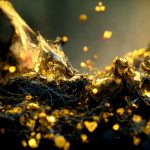
Table of Contents
Introduction: A Brief History of Gold in Glass Art
Gold has been used in glassmaking for centuries, dating back to the Roman Empire, where it was used to decorate glass vessels. Over time, gold became more accessible, and glassmakers began using it to create gold-colored glass and gold-leaf decorations on their works of art. Today, gold remains a popular and luxurious element in glass art, adding a touch of glamour and elegance to even the most simple designs.
The Definition and Significance of Gold in Glass Art
In glass art, gold refers to the use of gold-colored glass or gold-leaf decorations. Gold in glass art symbolizes luxury, wealth, and beauty. It adds a significant value to the artwork and is often used to create intricate patterns and designs. Gold is an excellent material for glass art as it can withstand high temperatures and retain its color and shine over time.
Gold-Colored Glass: The Process and Characteristics
To create gold-colored glass, gold is added during the glass-blowing process. Depending on the amount of gold used, the glass can have a range of colors, from a pale gold to a deep, rich amber color. Gold-colored glass is often used in traditional glass-blowing techniques, such as Venetian glass, where it is used to create intricate patterns and designs.
Gold-Leaf Decorations: Adding Elegance and Glamour
Gold-leaf decorations involve using small layers of gold to decorate the surface of the glass. This technique is often used on engraved or etched glass designs, creating a stunning contrast between the gold and the clear glass. Gold-leaf decorations can also be added to the rim or base of a glass, adding a touch of elegance and glamour to the piece.
Inspiring Examples of Gold in Glass Art
Some of the most inspiring examples of gold in glass art come from ancient cultures such as the Roman, Islamic, and Byzantine societies. However, modern glass artists continue to use gold in their work, creating stunning contemporary pieces. Some examples include the intricate and delicate gold-leaf decorations on antique Venetian glassware, and the abstract gold patterns found on modern Murano glass sculptures.
The Timeless Value of Gold in Glass Art
Throughout history, gold has played a significant role in glass art, adding a touch of luxury and elegance to even the simplest designs. Today, gold continues to be a popular element in glass art, creating stunning pieces that are both beautiful and valuable. Whether used to create gold-colored glass or gold-leaf decorations, the timeless value of gold in glass art will continue to inspire and enchant artists and collectors alike for years to come.
Summary and Conclusion
Gold in glass art adds a touch of glamour, luxury, and elegance to even the simplest designs. Gold has been used in glassmaking for centuries, with examples from ancient Roman, Islamic, and Byzantine societies. Today, gold remains a popular material in glass art, used to create gold-colored glass and gold-leaf decorations. Whether used to create intricate patterns or add a touch of elegance to a piece, the timeless value of gold in glass art will continue to inspire and enchant artists and collectors alike for years to come.





